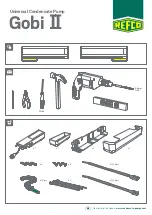
5808011-JIM-A-0320
64
Johnson Controls Ducted Systems
UCB de-energizes the indoor blower following the elapse of the
fan off delay for heating.
If voltage is sensed at the GV for at least 15 seconds during the
fan on delay for heating and GV voltage or W1 is lost, the
indoor blower is forced on for the length of the fan off delay for
heating.
During a call for heat, if the UCB does not sense voltage at the
GV for a continuous five-minute period, the UCB initiates a error
message. The indoor blower motor is not locked on while there
is no GV voltage.
Safety controls
The UCB monitors the temperature limit switch of gas heat
units.
The control circuit includes the following safety controls:
Limit switch
The limit switch (LS) is located inside the gas heat compartment
and is set to open at the temperature indicated in Table 12. It
resets automatically. The limit switch operates when a high
temperature condition, caused by inadequate supply air flow
occurs. This shuts down the heater and energizes the blower.
Auxiliary limit switch
The auxiliary limit switch (ALS) is wired in series with the limit
switch. As such, the UCB cannot distinguish the auxiliary limit
and the gas heat limit switch operation except the auxiliary is
manual reset. Consequently, the control responds in the same
manner as outlined in
The ICB monitors the pressure and roll out switches of gas heat
units.
The control circuit includes the following safety controls:
Pressure switch
When the draft motor has reached full speed and closes the
pressure switch (PS) during a normal ignition sequence, if the
pressure switch opens for 2 seconds, the GV is de-energized,
the ignition cycle is aborted, and the ICB flashes the
appropriate code. For information on the ignition control flash
codes, see Table 31 on page 74. The draft motor is energized
until the pressure switch closes or W1 is lost.
Roll-out switch
The roll-out switch (ROS) is wired in series with the pressure
switch. As such, the ICB cannot distinguish the roll-out switch
operation from that of the pressure switch.
Consequently, the control only responds in the same manner
as outlined in
on page 64. An open roll-out
inhibits the gas valve from actuating.
Internal microprocessor failure
If the ICB detects an internal failure, it ceases all outputs,
ignores inputs, and displays the proper flash code for control
replacement. The ICB remains in this condition until it is
replaced.
Flash codes
The ICB initiates a flash code associated with errors within the
system, Table 31 on page 74.
Resets
Resets remove the call for heating by lowering the thermostat
setting lower than the conditioned space temperature. This
resets any flash codes.
Gas heat anticipator setpoints
The anticipator setpoint must be correct. Too high of a setting
results in longer heat cycles and a greater temperature swing in
the conditioned space. Reducing the value below the correct
setpoint gives shorter ON cycles and may result in the lowering
of the temperature within the conditioned space. See Table 26
for the required gas heat anticipator setting.
Cooling start-up
Pre-start checklist
When the installation is complete, perform the following checks:
1.
Check the electrical supply voltage being supplied. Verify
that it is the same as the voltage listed on the unit
nameplate.
2.
Set the room thermostat to the off position.
3.
Turn on electrical power to the unit.
4.
Set the room thermostat fan switch to on.
5.
Check the indoor blower rotation.
• If the blower rotation is in the wrong direction, see
Check the blower drive belt tension.
6.
Check the unit supply air (CFM).
7.
Measure the evaporator fan motor's amp draw.
8.
Set the room thermostat fan switch to off.
9.
Turn off electrical power to the unit.
Operating the unit
1.
Turn on electrical power to the unit.
Note:
Before each cooling season, you must energize the
crankcase heaters at least 10 hours before the system
is put into operation.
2.
Set the room thermostat setting lower than the room
temperature.
Table 26: Gas heat anticipator setpoints
Setting, amps
W1
W2
0.65
0.1
















































